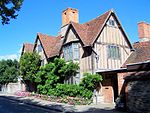Stratford-upon-Avon Racecourse Platform railway station
Disused railway stations in WarwickshireFormer Great Western Railway stationsPages with no open date in Infobox stationRailway stations in Great Britain closed in 1968Railway stations in Great Britain opened in 1933 ... and 1 more
Use British English from November 2016
Stratford-upon-Avon Racecourse Platform was a railway station on the Stratford upon Avon to Cheltenham section of the Honeybourne Line. Located one mile (1.6 km) south of the town centre, its purpose was to serve Stratford Racecourse. It closed in 1968 as a result of falling passenger numbers. The site of the station has now long been a part of the Stratford-upon-Avon greenway, however the site (which once served the racecourse) may one day in future become the northern terminus of the preserved Gloucestershire Warwickshire Railway, which aims to eventually extend north-eastwards to Stratford-upon-Avon.
Excerpt from the Wikipedia article Stratford-upon-Avon Racecourse Platform railway station (License: CC BY-SA 3.0, Authors).Stratford-upon-Avon Racecourse Platform railway station
Stratford Greenway, Stratford-on-Avon
Geographical coordinates (GPS) Address Nearby Places Show on map
Geographical coordinates (GPS)
| Latitude | Longitude |
|---|---|
| N 52.184 ° | E -1.7149 ° |
Address
Stratford Greenway
Stratford Greenway
CV37 9LE Stratford-on-Avon
England, United Kingdom
Open on Google Maps









